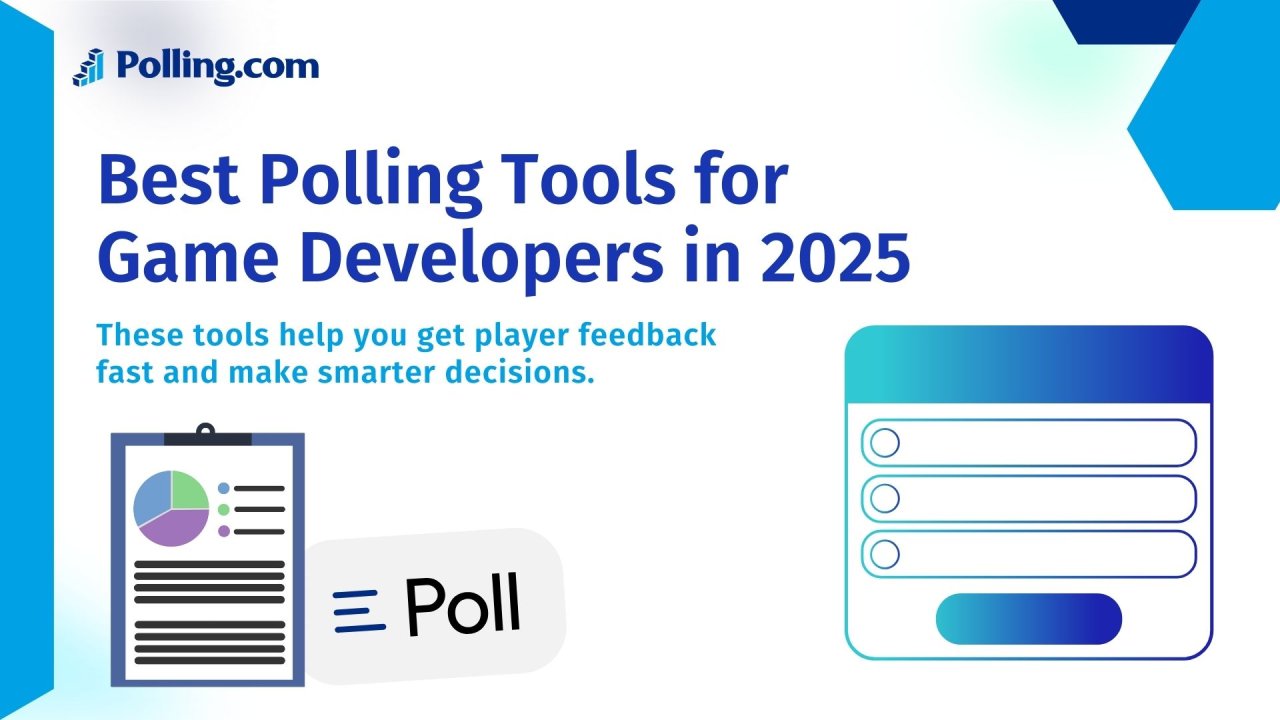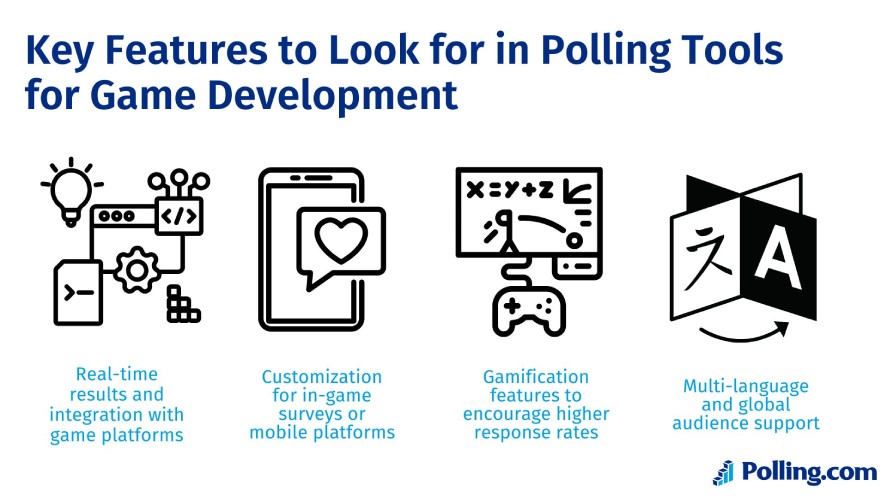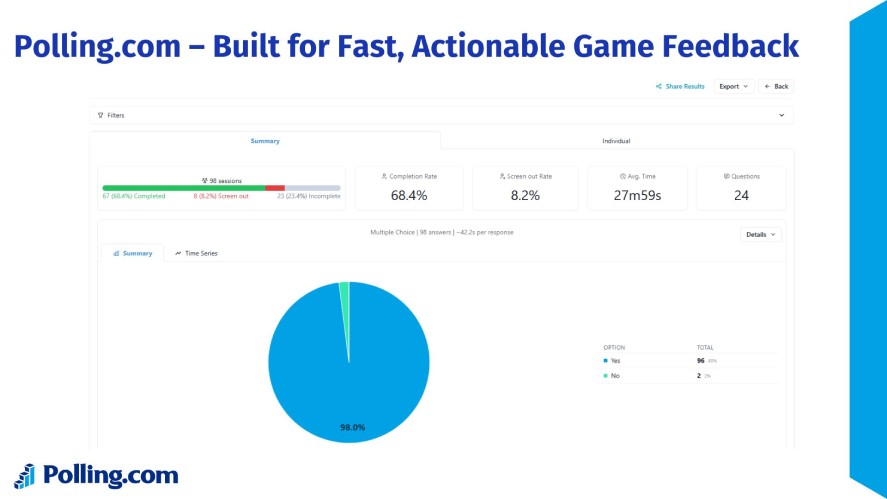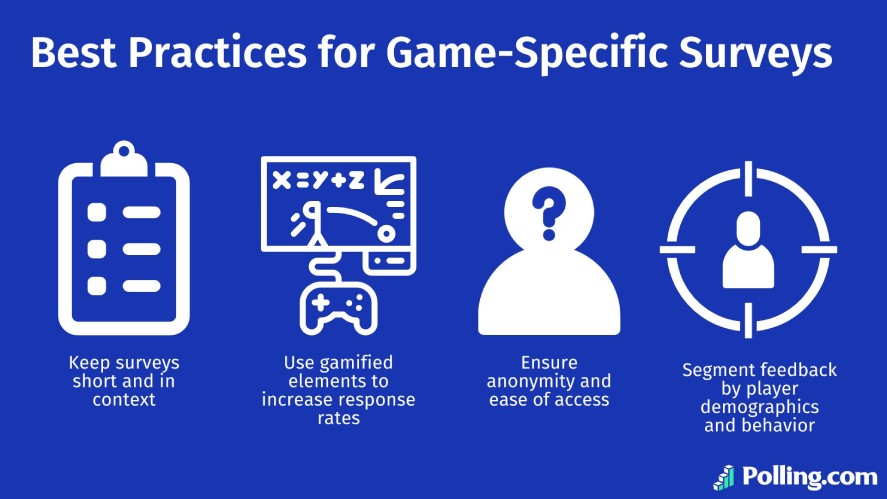
Best Polling Tools for Game Developers in 2025
Picture launching a game, only to find players bailing because the controls feel clunky or the story’s a snooze.
In 2025, game developers can’t afford to guess what players want, whether through online poll makers, in-game forms, or quick feedback prompts, they need game feedback straight from the source.
With gamers expecting polished experiences, studios are leaning on polling tools to make data-driven calls, from tweaking mechanics to boosting retention.
These tools, from interactive poll solutions to feedback collection platforms, let you ask players what’s working, what’s not, and what they’re craving, turning community feedback into gold.
Leading the pack? Polling.com, a powerhouse for agile, scalable gaming surveys that helps studios nail player vibes and build games that stick.
This article breaks down why polling tools are a must for game devs and what to look for in the best ones.
Why Game Developers Need Polling Tools
Polling tools are like a direct line to your players’ brains, helping you craft games that hit the mark. Here’s why they’re non-negotiable for game development feedback.
First, they’re key to understanding player behavior and preferences.
Want to know if your new RPG’s combat feels epic or frustrating? A quick poll can reveal if players love the mechanics or ditch the game at level 5.
Survey analytics from tools like Polling.com show clear patterns, like 60% of players wanting more co-op modes, so you can prioritize what matters.
This beats guessing and keeps your survey in games focused on real player needs.
Next, game feedback drives better mechanics, UI/UX, and storylines.
Imagine players griping about a confusing menu in your shooter, a poll might show 70% struggle to find settings, pushing you to streamline the interface.
Or, if your story’s losing folks, gaming surveys can pinpoint where the plot drags, letting you spice it up. Insights like these, backed by hard data, make your game sharper and more fun.
Finally, polling tools boost user retention through community-driven development.
When players see their community feedback shaping updates, like adding a requested feature, they stick around. A study found 78% of players feel more invested when their input’s acted on.
By using survey games to involve your community, you build loyalty, turning casual players into fans who keep coming back.
Key Features to Look for in Polling Tools for Game Development
Not all polling tools are created equal, so here’s what to hunt for to get the best game analytics and player insights in 2025.

Real-time results and integration with game platforms are a must.
You need instant data to act fast, like spotting a bug that’s tanking your engagement rate during a beta test.
Tools like Polling.com sync with Unity or mobile platforms, feeding survey analytics straight into your workflow, so you’re not stuck waiting for reports. This keeps your game development feedback loop tight and actionable.
Customization for in-game surveys or mobile platforms is another biggie.
Players won’t pause their game for a long survey, so you need short, slick polls that blend into the experience, like a post-level question on difficulty.
Fortunately, Polling.com lets you tailor gaming surveys for mobile or PC, ensuring they feel native, not clunky. Remember to keep your surveys under 5 minutes to boost completion rates.
In addition, gamification features can skyrocket response rates.
Offering in-game rewards, like coins or skins, for completing a poll makes players eager to share, especially when using free poll generators with built-in gamification.
For example, a company saw higher participation with hard currency rewards for surveys. Polling tools with gamified elements, like progress bars or fun visuals, make start survey games engaging, driving up your community feedback volume.
Multi-language and global audience support is crucial for reaching diverse players.
If your game’s big in Japan and Brazil, your survey in games needs to speak the local lingo. Polling.com offers multilingual templates and global analytics, letting you compare game feedback across regions without missing a beat.
This ensures your survey analytics capture the full player vibe, no matter where they’re gaming.
Top Polling Tools for Game Developers
Picking the right polling tools can make or break your game feedback strategy. So, let’s check out the best options for 2025, from indie devs to big studios.
1. Polling.com – Built for Fast, Actionable Game Feedback
Polling.com is the gold standard for gaming surveys, designed with game devs in mind.
Its real-time dashboards let you track player sentiment analytics instantly, like seeing 65% of players hate a new boss fight during a soft launch.
It integrates seamlessly with game engines like Unity and Unreal via APIs, making survey in games deployment a breeze, whether you’re pushing polls to mobile or PC.

In addition, Polling.com’s custom polling widgets blend into your game’s UI, so a quick “Rate this level” pop-up feels natural, not jarring.
For scalability, Polling.com’s infrastructure handles both indie devs and large studios, supporting thousands of responses without a hitch, unlike generic tools that lag under load.
Its survey analytics dive deep, offering sentiment tracking to gauge if players are hyped or frustrated, helping you tweak game features fast.
Compared to Typeform’s pretty forms or SurveyMonkey’s enterprise heft, Polling.com outshines with game-specific integrations, lower costs (free tier included), and a focus on community feedback analysis that’s tailor-made for devs, making it the top pick for how to handle feature requests.
2. Typeform
Typeform shines for visually engaging forms, perfect for gaming surveys that need to pop.
Its interactive, mobile-friendly polls, like a sleek “Choose your favorite character” quiz, boost engagement rate. But it’s not built for gaming, lacking direct Unity or Unreal integrations, so in-game deployment feels clunky.
It’s great for external feedback, like post-launch surveys, but less ideal for real-time game analytics or scalable survey in games. This makes it better for indie devs who prioritize style over deep integration.
3. Google Forms
Google Forms is the go-to free survey maker, simple and no-cost for cash-strapped devs.
You can whip up a poll for game feedback, like asking “What’s your top genre?” and share it via Discord or email. Results feed into Google Sheets for basic survey analytics, but that’s where it stops.
No real-time game engine integration, no in-game widgets, and no gamification mean it’s a barebones option. It’s fine for small indie teams but falls short for community feedback analysis or large-scale gaming surveys.
4. SurveyMonkey
SurveyMonkey brings enterprise-grade features, like advanced analytics and CRM integrations (Salesforce, HubSpot), great for studios with big budgets.
Its survey analytics include sentiment analysis, handy for digging into player sentiment analytics on game features. But it’s pricey, and its generic design isn’t tailored for survey in games, lacking game engine APIs or in-game deployment options.
For game development feedback, it’s overkill for indies and less focused than Polling.com, making it a solid but costly choice for large studios needing broad community feedback.
How to Integrate Polling Tools into Your Game Development Workflow
Audience engagement tools are only as good as how you use them, so here’s how to weave them into your workflow for killer game analytics at every stage.
During alpha and beta testing, polling tools like Polling.com help you catch issues early.
You can drop a quick poll in your RPG’s beta, asking “Is the crafting system fun?”. If 60% of testers say it’s too grindy, you can tweak it before launch.
Polling.com’s Unity integration lets you embed these gaming surveys right in-game, with real-time survey analytics showing results as they roll in, keeping your iterations tight.
In post-launch, player satisfaction surveys keep your game alive.
For example, after dropping a new shooter, you use Polling.com to ask 10,000 players, “How’s the new map?”. If survey in games data shows 75% love it but 20% hate the spawn points, you’ve got a clear fix.
Polling.com’s dashboards also make community feedback analysis a snap, letting you spot trends fast, unlike clunky tools that bury insights.
For balancing updates and new features, feedback loops are your friend.
Say your MOBA’s latest patch nerfed a hero, and players are raging. A Polling.com poll asking “Rate the balance changes” might show 55% dislike the nerf.
Use game feedback to roll back or tweak, then re-poll to check if players are happier. This cycle, fueled by survey analytics, keeps your game fresh and players hooked.
Best Practices for Game-Specific Surveys
To get the most out of polling tools, your gaming surveys need to be player-friendly and smart, so here’s how to nail it.

First, keep surveys short and in context.
Players hate long forms, so ask one or two survey gaming questions, like “How’s this boss fight?” right after a level is perfect.
We suggests under 5 minutes for max completion, and Polling.com’s in-game widgets make this easy, blending polls into the flow for better engagement rate. Also, context matters, don’t ask about menus during a cutscene.
Next, use gamified elements to boost response rates.
Reward players with in-game loot, like XP or skins, for answering. This can lift game feedback volume by 20%, per industry trends, making your community feedback richer.
In addition, ensure anonymity and ease of access in your game surveys. Players won’t share if they feel exposed, so Polling.com’s anonymous survey in games options build trust.
Make polls mobile-friendly and skippable, as no one likes forced forms. Easy access drives up survey analytics quality, letting you focus on real player vibes.
Lastly, segment feedback by player demographics and behavior.
Use Polling.com to split data by age, region, or playtime, like finding casual players love your arcade game’s art but hardcore players want tougher modes.
This community feedback analysis helps you tailor updates, like adding difficulty sliders, to keep all players happy, boosting retention.
Final Thoughts
In 2025, polling tools are a game-changer for developers, turning game feedback into a roadmap for epic mechanics, tight UX, and loyal players.
Whether you’re testing a beta, balancing patches, or chasing higher engagement rate, tools like Polling.com give you the edge with real-time survey game data analytics, slick in-game polls, and deep community feedback analysis.
Forget guessing what players want, Polling.com’s developer-friendly platform, with its free survey maker tier and robust integrations, delivers data that drives hits.
Ready to level up your game? Test-drive Polling.com’s free tools today and see why it’s the go-to for game development feedback that wins players’ hearts!
